Steven Kramer has released the second edition to this popular textbook in order to remain in sync with the developments and changes in the audiology profession over the last five years. The textbook has retained many concepts from the first edition and has been updated and reorganised. Supplementary material from the first edition has now been combined with the main content and the textbook also includes two new chapters on clinical pure-tone masking and hearing screening.
James Jerger has revised his contribution on the historical pathway of audiology and now includes input from Cheryl De Conde Johnson on educational audiology. In addition, H Gustav Muellar and Earl E Johnson have also updated their contribution by providing an outstanding chapter on hearing aids, including advances in technology and cochlear implants.
This edition shares an equal aim to provide undergraduate students in audiology, or other healthcare professionals who may have little or no background knowledge, with an insight to the fundamentals of hearing science leading to enhanced clinical practices.
The author yet again sets out to present challenging and comprehensive information in an easy to understand manner, supported by figures and tables. Each chapter includes a key list of objectives; additionally, most chapters have prefaces with synopses that serve as a quick reference or review of the section.
The first chapter draws readers’ interest with extensive coverage of anatomy and physiology of the auditory and vestibular systems. The following chapters ensure the reader is well equipped to apply this knowledge to clinical practices.
This textbook is an exceptional read and is likely to facilitate improved clinical practices. The companion workbook, Audiology Workbook – Second Edition, likewise has been updated with additional related questions and answers.
Audiology Science to Practice - Second Edition, reflects the advances in audiology well and I would recommend this book to those with interest in the world of audiology, existing practitioners and those keen to extend their knowledge in this field. The easy-to-read format and style, use of figures and tables, learning objectives and companion workbook ensure that even the most challenging topics are easy to grasp.




